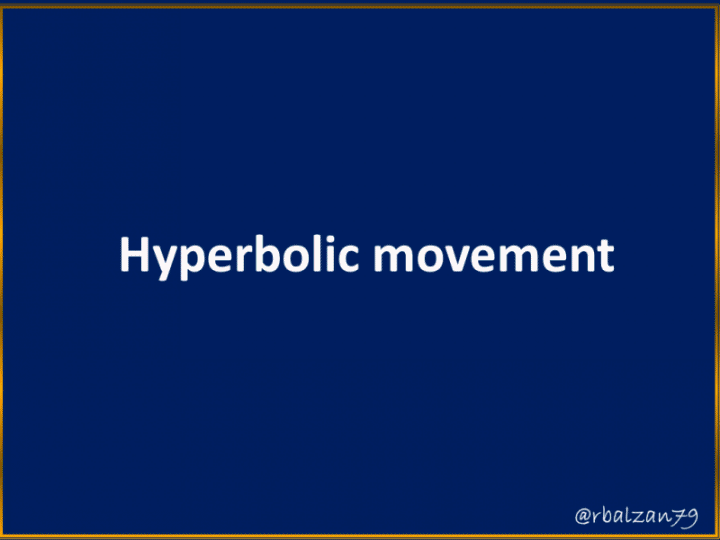
Greetings to the entire steemit academic and scientific community.
Introduction
In our nature we can observe any type of mobility carried out by a particle, body or object and between this type of movement we visualize the hyperbolic movement, a phenomenon that represents another form of curvilinear mobility such as the circular, parabolic and elliptical as we could see in previous publications.
With the hyperbolic movement we could express that we would be consolidating the four fundamental mobilities or bases for the rest of the movements that originate in our majestic universe, of these basic movements, two are closed or cyclical (circumference and ellipse) and the other two are open (parabola and hyperbola).
Each observed movement has its particular behavior or characteristic representing the most fundamental type of trajectory described by a given body or mobile, this is what determines the name of these phenomena as we could see and verify with the previous movements, the circular, parabolic and elliptical, and their geometric trajectories, circumference, parabola and ellipse respectively.
It is essential to connect with the particular trajectory of the hyperbolic movement, that is to say, with the geometric place of the figure called hyperbola, geometric form that attributes the name to this mobility phenomenon, and therefore we will know some of its main characteristics from the geometric point of view, used by the kinematics for the analysis of the hyperbolic movement.
If we enter the world of astronomy we find this type of hyperbolic movement, since the trajectory followed by a particular comet or asteroid when it passes through the solar system attracted by the gravitational force of the Sun, is that of a hyperbola, therefore they develop a hyperbolic movement.
The orbits carried out by any particle or body of our universe will depend on the degree of eccentricity of them, since we can find circular orbits because their eccentricity is equal to 1, in the case of elliptical orbits the eccentricity will be between 0 and 1, as for parabolic orbits its value will be equal to 1, and for orbits that describes a hyperbolic mobility the eccentricity is greater than 1.
Therefore, this is an important characteristic to take into account in relation to the type of orbit developed by a particular particle, body or object, either within or outside the reach of the gravitational force or action of the earth or our solar system, originating in this way the different orbits described above.
Hyperbola
This figure or geometric form has made possible the comprehension of the hyperbolic movement, this phenomenon is in several aspects of our nature, for example, several celestial or astronomical bodies of our universe carry out this mobility, among other cases of bodies or particles that describe in their path the path of hyperbolic form.
Then, this figure represents the geometrical place created by the movement of a given point in the coordinated rectangular plane, where the absolute value of its difference or subtraction of its distance to two fixed points called focal points will always be the same, therefore a constant amount, positive and also less than the focal distance, ie the distance between the focuses.
Knowing the conceptual aspect of this geometric figure, it is necessary to know the elements that make up or constitute the hyperbola as shown below in figure 1.
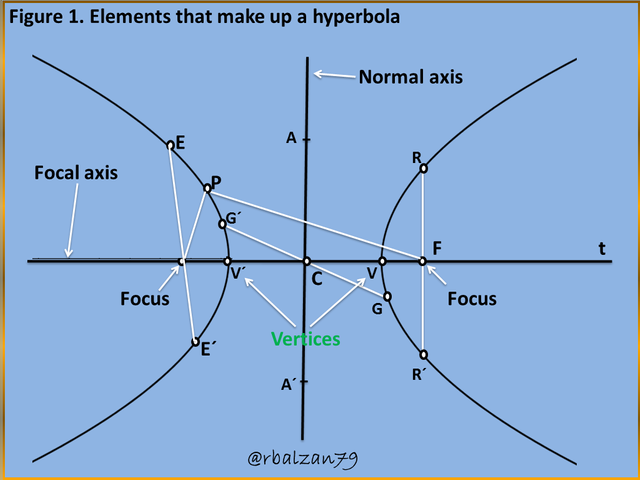
With the previous figure 1, we can visualize the behavior of the trajectory or path of the hyperbolic movement, thus constituting an elementary figure for the analysis of hyperbolic movement.
Hyperbolic Movement
Before coming to this article we analyzed three important and vital curvilinear movements such as the circular, the parabolic and the elliptical, where we highlight the valuable role that each of them have in our universe and therefore in our lives, now it is up to the hyperbolic movement to show us their characteristics and importance among all of us.
According to the above, we could express in a general way that a certain particle, body or object can move following a hyperbolic movement when in its trajectory or path it describes the geometric place of a hyperbola, it is important to highlight the essential element of eccentricity that characterizes each one of these conical figures and their respective movements.
A type of hyperbolic movement from the point of view of astronomy (celestial mechanics) is that described by a particular particle, body or object which escapes the gravitational attraction of a particular central body, representing two clear examples of central force bodies, the Sun, for our planetary system, and planet earth for the moon and artificial satellites.
In relation to the Newtonian theory, the type of orbit that will describe this particle, body or object, will be the geometric place of a hyperbola, this is essentially based on the type of eccentricity (e) of this crossed orbit which is greater than one (1).
We must bear in mind that if we are in the presence of a field of repulsion, the trajectory followed by any particle or body that wants to approach it will always be that of the geometric place of a hyperbola, describing then the known and important hyperbolic movement.
An example of this type of trajectory is the dispersion of the alpha particles by the atomic nuclei, due to the fact that when shooting particles of this type towards the nucleus of a certain atom there will come a moment in which some will be repelled by this nucleus, following in this way hyperbolic trajectories, as we can observe in the following figure 2.
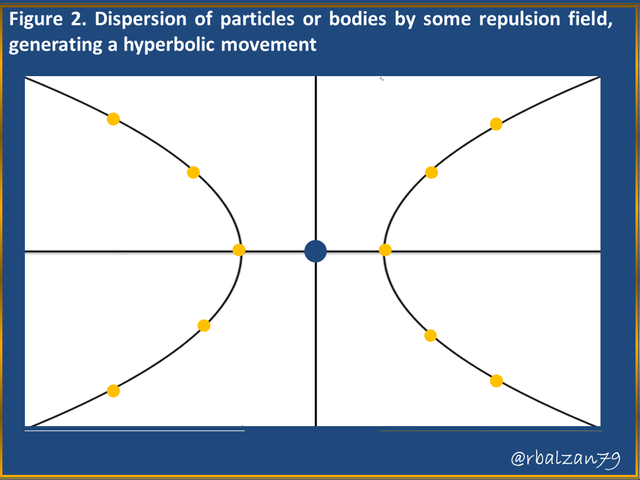
This activity was developed experimentally by the physicist Ernest Rutherford, because one of the most important characteristics of the hyperbola and therefore of the hyperbolic movement is its eccentricity (e) it is important to know this equation:

It is important to always remember that the different orbits that develop in our universe will depend on the degree of eccentricity (e) of their trajectory or path, therefore, we have that for circular orbits, the eccentricity will be equal to zero (0), elliptic will be between zero (0) and one (1), i.e. greater than zero but less than one, parabolic will be equal to one (1), and for hyperbolic orbits the eccentricity will be greater than one (1).
The eccentricity of the hyperbola offers an orbit to any body or object that allows it to escape from the gravitational action of a given body of central force, highlighting again the eccentricity characteristic of such an orbit and its value as already expressed is greater than one (1), this allows us to remember the equation for the escape velocity:
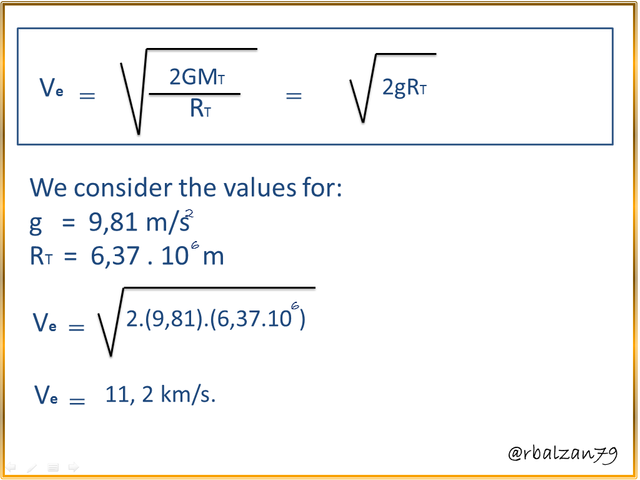
Therefore, it is the speed necessary for a body to leave the attraction of the gravitational field of the earth, because knowing this value we could determine the path or trajectory of any type of orbit of a particle body or object, this from the astronomical point of view.
Once the value of this initial escape velocity is known, we can mention that this type of displacement is also known as escape trajectories according to the case study, as for example in the launch of artificial satellites which may describe different trajectories such as that of a circle, parabola, ellipse and hyperbola.
The orbit to be described by these satellites will depend on the speed with which they are launched, if this speed is below the escape speed, the satellite will describe a circular or elliptical orbit, but if the speed is equal to the escape speed the trajectory of the orbit will be parabolic, and if this speed is greater than the escape speed the trajectory of the orbit will be that of a hyperbola, developing a hyperbolic movement.
Another example is the launch of a rocket or any projectile or ship into space. It must reach and exceed the escape velocity in order to overcome the gravitational force with which the rocket is attracted by the mass of the Earth, as we can see in the following figure 3.
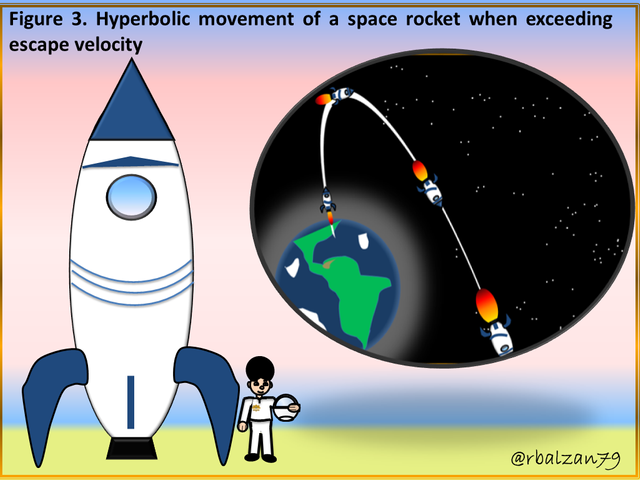
If we talk about our Solar System we would find a movement carried out by certain comets with non-periodic orbits, which are generally attracted by the gravitational force of the Sun (or by any other celestial body) which would act as one of the focuses of the hyperbola, and the same (comet) would travel a hyperbolic trajectory, as we can see in the following figure 4.
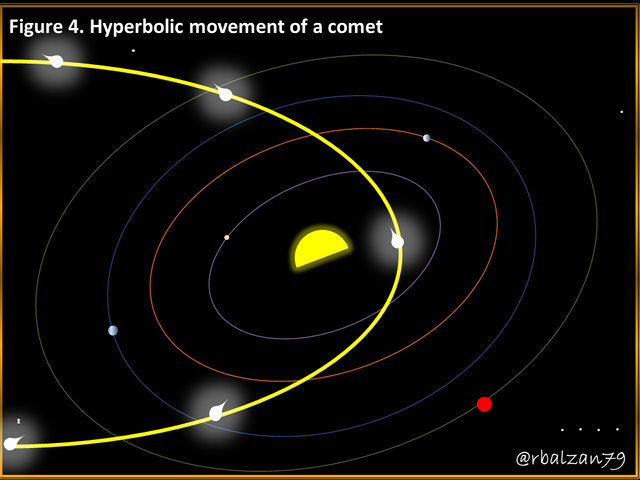
If we place ourselves in our terrestrial crust specifically in maritime waters we also find a type of hyperbolic movement developed by a certain nautical vessel through the application of a communication system called LORAN (Long Range Navigation).
This system is conformed by two lighthouses radios which capture or receive communication from any boat, where the difference between the distance to these lighthouses radios with respect to the boat will be constant, this is one of the main characteristics or properties of this type of hyperbolic trajectory, as we can see in the following figure 5.
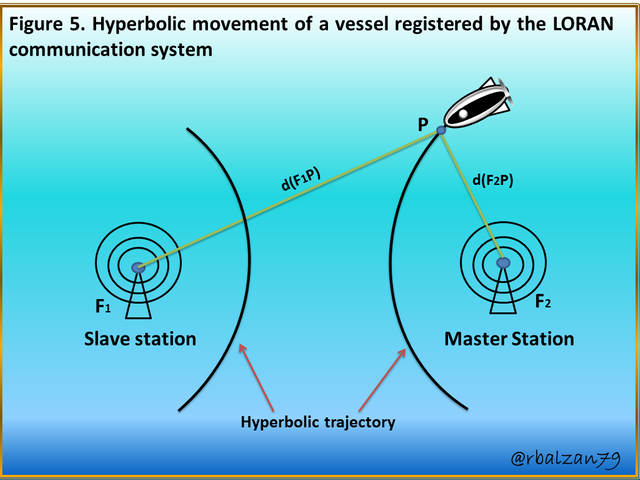
Conclusion
No one can deny that the marvelous phenomenon of movement has left its shocking traces in humanity, without their understanding and comprehension our fabulous intellectual and social development would undoubtedly be much lower, or we would not have managed to be the living species that we are today.
Then, we could affirm that this phenomenon forms and will form part of our existence and that thanks to the extraordinary field of science we have been able to transmit the language of movement to any person on this planet with the firm purpose of improving our lives.
It is important to take into account the shape of the trajectory followed by any particle or body that we observe in our environment, this will determine the type of mobility we want to analyze, as we could visualize with the hyperbolic movement and its trajectory in the form of the geometric figure we know as hyperbola.
This article allowed us to understand and analyze some general characteristics of hyperbolic orbits and their geometric relationship with the figure of the hyperbola, taking into account one of its fundamental characteristics such as its eccentricity, all this under the help of astronomy and its celestial mechanics, where geometric forms such as the hyperbola have provided their essential contributions as trajectories.
Many are the examples that we could find in our majestic universe related to this type of movement, as we demonstrated in the development of this article, the important thing is to be able to highlight the essential or vital role that the phenomenon of movement has in our lives and their particular forms of mobility, such as hyperbolic movement.
Until another opportunity my esteemed readers of steemit, especially the members of the great community #steemstem, for which I highly recommend to be part of this beautiful project, as it highlights the valuable work of academia and the scientific field.
Note: All images were created using the Paint, Power Point and animated gif applications with the PhotoScape application.
Bibliographic references
[1] Charles H. Lehmann. Analytic geometry.
[2] Lior M. Burko and Richard H. Price. Department of Physics, University of Utah, Salt Lake City.
[3] Snapper, E., Troyer, R.J. Metric Affine Geometry. Dover, New York, 1971.
[4] O. Montebruck, E. Gill. Satellite Orbits, Springer.
[5] Williams J. Astore, Robert B. Giffen, Wiley J. Larson, Understanding Space, second edition, 2004.
[6] Joel Franklin, David Griffiths. The fields of a charged particle in hyperbolic motion. February 2014.
[7] J.Peraire, S. Widnall. Central Force Motion: Orbits. Version 1.1. Fall 2008.
excelent vision, my friend. Congrats!!
Downvoting a post can decrease pending rewards and make it less visible. Common reasons:
Submit
Thank you for your comment. Greetings.
Downvoting a post can decrease pending rewards and make it less visible. Common reasons:
Submit
This post has been voted on by the SteemSTEM curation team and voting trail. It is elligible for support from @curie and @minnowbooster.
If you appreciate the work we are doing, then consider supporting our witness @stem.witness. Additional witness support to the curie witness would be appreciated as well.
For additional information please join us on the SteemSTEM discord and to get to know the rest of the community!
Thanks for having used the steemstem.io app and included @steemstem in the list of beneficiaries of this post. This granted you a stronger support from SteemSTEM.
Downvoting a post can decrease pending rewards and make it less visible. Common reasons:
Submit
Excellent content shown in this publication friend @rbalzan79, especially considering the quality of the images that make faithful reference to the hyperbolic movement in its diversity of forms. Greetings and thanks for sharing.
Downvoting a post can decrease pending rewards and make it less visible. Common reasons:
Submit
Thank you for your comment @carlos84. Greetings.
Downvoting a post can decrease pending rewards and make it less visible. Common reasons:
Submit